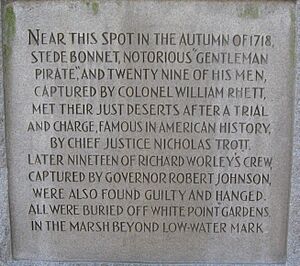Battle of Cape Fear River (1718) facts for kids
Quick facts for kids Battle of Cape Fear River |
|||||||
|---|---|---|---|---|---|---|---|
| Part of the Golden Age of Piracy | |||||||
 A map of the Cape Fear River |
|||||||
|
|||||||
| Belligerents | |||||||
| Commanders and leaders | |||||||
| Strength | |||||||
| 2 sloops | 3 sloops 3 canoes |
||||||
| Casualties and losses | |||||||
| 30 killed and wounded | 12 killed and wounded 41 captured 3 sloops captured 3 canoes captured |
||||||
The Battle of Cape Fear River was a fight in September 1718. It happened between a British naval group from South Carolina and the pirate ships of Stede Bonnet. The British forces won this battle in the Cape Fear River mouth. This victory led to Bonnet's capture and later justice in Charleston.
Contents
During the end of the Golden Age of Piracy, the British navy was always fighting pirates. These battles happened in the Caribbean and near North America. Stede Bonnet was a very successful pirate. He had captured many merchant ships and built his own group of pirate ships.
In August 1718, Bonnet was sailing towards the Cape Fear River. He was in charge of his main ship, the Royal James. This was a fast sailing ship, armed with eight cannons. He also had two other armed ships, the Francis and Fortune. About 46 pirates were on these ships.
The Royal James needed repairs to its bottom. Also, the stormy season was coming soon. So, Bonnet chose the Cape Fear River mouth as a safe place from storms. For a few weeks, Bonnet's crew fixed the Royal James. They used materials from a small boat they had captured.
In late August, news of Bonnet's ships reached Governor Robert Johnson of South Carolina. Governor Johnson ordered a military leader, William Rhett, to stop the pirates. Colonel Rhett did not have regular navy sailors. Instead, he had sailors from Charleston. He had two ships, each with eight cannons, and about 130 men.
The Battle Begins
Colonel Rhett reached the Cape Fear River mouth on the night of September 26, 1718. Bonnet and his men saw the ships. They thought the ships belonged to merchants. So, the pirates got into three small canoes. They paddled towards the unknown ships from South Carolina.
At this time, Rhett's main ship, the Henry, got stuck on a sandbar. A sandbar is a shallow area of sand in the water. This allowed the canoes to get close enough to see who the grounded ship was. Once they knew it was a British military ship, they quickly turned around. They paddled back to their own ships without being harmed.
Instead of escaping up the river in the dark, Bonnet decided to fight his way out. The next morning, at daylight, the pirates got ready to pass the two British ships. The British ships were now free from the sandbar. The pirates spread out among the Royal James, Fortune, and Francis. They loaded their weapons.
At dawn, Bonnet raised his pirate flag and attacked. They sailed for a few minutes until they were close enough to the enemy ships. Then, they started firing cannons and muskets. The British ships fired back and split up. But the Henry got stuck on a sandbar again, along with the other British ship. To avoid enemy fire, Stede Bonnet steered his ships close to the western side of the river. His ships also got stuck on sand.
At this point, only the Henry and the Royal James were close enough to shoot at each other. For five to six hours, the two sides fought. Neither ship could move. The Henry was stuck in a spot where its crew had little cover from enemy fire. The Royal James was in a better spot. Its hull protected the crew from incoming shots.
During the fight, Bonnet stayed on his ship's deck. He held his pistol and warned that he would shoot any man who showed fear. But the pirates were brave. They cheered each other on and dared the South Carolinians to board their ship. After five hours of fighting, the South Carolinians had 30 men injured or who lost their lives. Nine pirates were also injured or lost their lives.
The End of the Battle
The British ships were stuck downstream. In the early afternoon, the water began to rise. This freed Rhett's ships, but Bonnet's ships stayed stuck. The British fixed their ropes and raised their sails. Soon after, the Henry was in a good position. It could fire its side cannons directly onto the deck of Bonnet's Royal James.
Bonnet told his gunner, George Ross, to light the gunpowder and sink the Royal James. But his remaining crew members had already given up. They convinced him not to sink the ship. After a few more moments of fighting, the Royal James was boarded. Its crew was captured.
After the Battle
The South Carolinians had twelve men who lost their lives and eighteen injured. The pirates had twelve men injured or who lost their lives. All the surviving pirates were captured. Bonnet was taken to Charleston. He arrived on October 3 to face charges of piracy.
Bonnet was kept separate from most of his crew. He was held for almost a month at a local official's home. With him were his boatswain, Ignatius Pell, and the sailing master, David Herriot. They all escaped with help from two enslaved people and a Native American.
Governor Robert Johnson immediately offered a large reward of £700. This reward was for anyone who could capture or stop the pirates. Herriot was found and stopped on Sullivan's Island a few days later. Bonnet, known as the Gentleman Pirate, was soon recaptured after a small fight on Sullivan's Island. He later faced justice on December 10, 1718.
Images for kids



